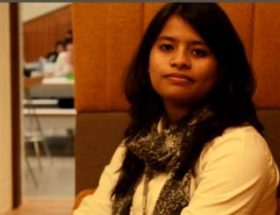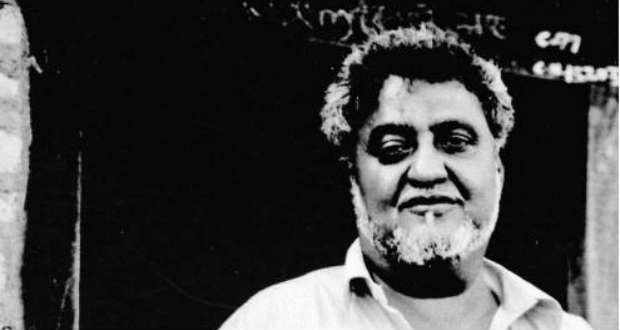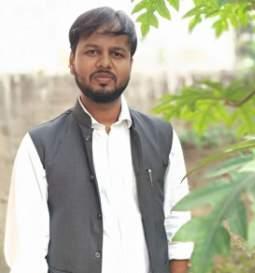Anbuselvam
A twenty-days painting exhibition titled an ‘Endless Canvas’ was held at Auroville Kala Kendra, Centre for Arts in Puducherry from 2015 September 25 to October 17. This exhibition showcased 35 paintings with the subjects unveiling an ancient anthropological view, acrylic brushed by a well-known thinker, cultural activist and a predominant Dalit artist K. Natarajan.
K. Natarajan works predominantly in the medium of canvas touching, but includes Dalit paintings in his large scale installations. He has had some solo shows at Appavu Gallery and the Art House Gallery in Chennai as well as group shows in Bengaluru. In 1997, the Dalit Resource Centre, Madurai, headed by Prof. Chandru, created an occasion and space for the ‘Colours of Liberation’ to emerge from the fingers of Dalit artists, with the slogan “Dalit arts are weapons for liberation”. K. Natarajan was then an art student of Dalit master Chandru in Chennai Fine Arts College.
After seven years, in 2004, the Dalit Resource Centre again organised a Dalit painting workshop in Madurai, headed this time by K. Natarajan with his team of 30 Dalit artists, amid the environment of atrocities on Dalits in the southern region. During this time they toured several villages in and around Madurai and Sivagangai districts, studying the folklore. They began work on the paintings which were displayed in a few places under the title of ‘Hidden feelings on Canvas’. The themes depicted the influence of folklore, local deities and the philosophy of the Buddha on the people. Their protection of the communities and how the Dalit Gods and Goddess were now being syncretisedby the Brahmanicalreligious forces. It is a good experience to understand our folk culture through the Dalit perspective.
The workshop process of putting together a collection of paintings under the appellation of Dalit art has been fraught with profound questions. Can art be labelled on the basis of identity or ideology of the artist? This major question was churning among the artists. Yes! Today we try to understand ourselves, if the art community is ready to enact such a role in the name of Dalit art.

At the inauguration of the exhibition
Working class community arts are liberating as long as they are with the oppressed, but when they became instruments of the oppressors, they lose their mutinous character. Dalits arts are liberating because they are owned, performed and enjoyed by Dalits. Yet Dalit arts have been ridiculed, looked down upon and ostracised as the artists and their instruments are considered polluting by dominant forces. While it has been possible to subjugate Dalits, one cannot kill their passion and zeal for liberation. Dalit arts reflect the life of Dalits, which is sustained through shedding sweat and blood. The expressions, the noises, the mourning and the silence of the arts, symbolise the struggle for liberation and the struggle to protect themselves and others. Dalit arts face death, yet they resurrect themselves again and again to continue the struggle against all forces of evil and all forms of oppression. It is fitting therefore to say Dalit arts are weapons for liberation. Along the same lines, the Dalit paintings have also recorded aesthetically the struggles, the protests, the love and compassion of Dalits. The Dalit artists have recovered some old memories and revealed fresh insights from our life experiences, which are battle fields of caste and untouchability (Anbuselvam, 2003: 7, Varna).

Natarajan’s works are purposely not highlighted as Dalit art. His painting with wounded colours, breaking lines, and burning dots, is an invitation to contemplate and reflect on life through a Dalit perspective. His solo exhibition in the ‘Endless Canvas’ depicts positive themes and imagination with subjects ranging from creation to resurrection of natural values. The canvas images should be seen as metaphors, symbols, symbols of life, of a critique of life and of life as it ought to be. Life of what people are, of what they endure, and of what they struggle against and strive afte, life of lament, protest, compassion, solidarity and hope. Studies in images, arts and aesthetics claim that symbols carry cognitive value that are instruments of Dalit intellectualism. If anyone studies these paintings for some time, they will begin to understand the rich experience of folklore aesthetics behind these canvases and colours by Natarajan.
He is a folklorist from Chennai slums. He knows well the history of early formations of Tamil Buddhism in Madras presidency through extensive readings of Pandit Ayotheedass. The Buddhist folklore meanings are reflected in the images he creates. They affirm a convergence of religion and Dalit aesthetic in the context of Tamil Buddhism. For example, a painting named ‘Elephant Hill’ is as much Dalit aesthetic as it is Buddhist folk imagery.

Natarajan with his team
Both art and religion have the capacity to envision the world, and in vision to transform it. Both integrate the sensory and the Dalit spiritual, and engage us wholly and touch us in the totality of our being, and affect the relations of heart and mind to the vital elements – human, cosmic and divine – of what one regards as the ultimately meaningful whole. Both of them enable us “to experience the familiar in unfamiliar ways” and open up new possibility of human relations. Both allow us to see more, feel more, think more, mean more and be and become more (Brown, 1989: 82). The historical connection of these paintings confirms the ‘crucial relationship’ that obtains between Dalit aesthetic and Buddhist folk religious phenomena.
So, Natarajan said,
I am creating a time that is my own thoughts on everything that passes – History, Geography, Science, Caste, Race, Language, Religion, Friendships, Relationships, Enmities . . . on this endless canvas of events where nothing stays, my paintings are those moments when I mark space that is truly mine.
These paintings, then, are an invitation to further explore and articulate situations and problems; criticisms and protests; liberation struggles and transformative efforts, as well as signify the creative presence of love and grace in the movements of oppressed people’s history. The hope is that there will be more and other responses to these paintings and colours. The paintings may have a different message for different people and diverse occasions just as the same word may be heard, interpreted and expressed in various ways by assorted listeners.
The invitation however, addressed to everyone, to look, to ponder, to seek and to act, stands and also advises to borrow the precious canvas itself.
~
References
* Anbuselvam. Varna (2003), Samvada Publications, Bengaluru.
* Brown, Frank Burch. Religious Aesthetics (1989), A Theological Study of Making and meaning, Princeton: Princeton University Press.
~~~
Anbuselvam is a writer and researcher.









